By Heather McCargo
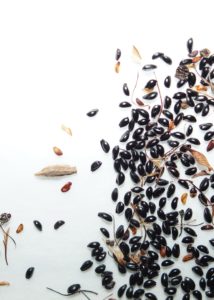
Columbine seeds (Aquilegia canadensis). Photo: ©Lisa Looke, courtesy of Wild Seed Project
The seeds of wild plants have different needs than those of typical garden and vegetable species. Most gardeners think of spring as the time to sow seeds, but for many native plants in the Northeast, late fall to early winter is the best time. The majority of wildflowers, trees and shrubs have seeds that need to experience a winter cold period before they will germinate. Some species also have seeds that must be sown as soon as they ripen. Many of the spring-blooming woodland wildflowers, and trees such as oaks, maples, willows and dogwoods, have moisture-dependent seeds that must not dry out. If they do, they will either go into an extended period of dormancy, or the seeds will become non-viable.
For individuals new to native seed sowing, many beautiful native species are easy to grow from seed, but the specific requirements for successful propagation must be understood to assure success. Fortunately, the methods are simple, and no sophisticated facilities are required as the seeds are ideally suited to germinate outdoors in beds or pots. Seed propagation is also an inexpensive way to produce a lot of plants.
A key benefit of growing native plants from seed is it is the best way to preserve the genetic diversity within a species. In the wild, most plants reproduce by seed. Seeds develop when flowers are pollinated (usually by insects, sometimes by the wind), mixing the genes of multiple individuals. This results in genetically diverse individuals. This variation is a wild plant’s best strategy to adapt to future environmental conditions as individuals differ in their ability to deal with drought, heat, flooding, cold and pollution. Genetic diversity is crucial to all species being able to change with a shifting climate.
Modern horticultural practices have shifted to favoring cloned plants, often individuals bred or selected with novel traits, called cultivars. The traditional way to clone plants is to dig up the plant and divide the root system into multiple pieces or to take stem cuttings and root them in a misting chamber. Increasingly today, many landscape plants are cloned in a laboratory with a process called tissue culture, where cells from a mother plant are cultured in a petri dish and stimulated into growth using a variety of synthetic chemicals – a practice counter to supporting natural plant evolution. With any of these methods, just one individual’s genes are propagated. With a rare species with no ability to reproduce sexually, this may be the only solution to perpetuating a species on the verge of extinction. With the rising interest in native plants for gardens and developed landscapes, it is essential that we preserve the genetic diversity within our native plants – gardens filled with cloned plants will not have the diversity needed to adapt to the vagaries of a changing environment. For our landscapes to be resilient, it is important that native plants are propagated from seed whenever possible. If many people started sowing native seeds, we could rapidly increase the resiliency of our landscapes and support the genetic diversity of our native flora.
There is another often overlooked benefit of outdoor propagation: plant health. Damping-off, fungal gnats, aphids, and algae growth – the bane of greenhouse and indoor seed starting – are nearly nonexistent with outdoor propagation. And now, with the widespread availability of organic potting mix, it is very easy to produce healthy plants.
My life’s work has focused on native plant ecology, seed propagation and organic horticulture. In 2014 I founded the Maine-based non-profit Wild Seed Project to create a grassroots movement to get lots of people growing native plants from seed. I have four decades of experience growing many different native species, and I am also an experienced organic vegetable and herb grower. In so many ways, I find sowing and growing natives much easier, and with outdoor propagation, the plants are healthy and robust. If you are one of those who always fail with seed germination indoors, you may very well find yourself successful with the methods I have used. Below I will explain how I do it.
Setting up an Outdoor Seed Propagation Area
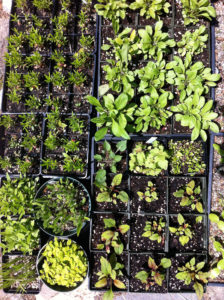
Hundreds of seedlings can be produced in a small space. Photo: ©Lisa Looke, courtesy of Wild Seed Project.
Seeds can be sown in pots or seed flats that are tucked out of the way in a shady location and covered with wire mesh to protect from rodents. A dozen 4-inch pots can fit under a slatted bench or table and take up very little space. A weed-free seedbed 4 feet wide by 4 to 12 feet long, edged with logs or lumber, also makes a nice area to grow seedlings. Woodland species need a mostly shady location, and sunny species need at least a half-day of sun. Hundreds to thousands of plants can be produced even in this small area. See How to Grow Natives From Seed for more information on setting up a native nursery.
Sowing the Seeds
The easiest way to ensure your native seeds get the winter cold they need to germinate is by sowing the seeds anytime from November to early February. Place the pots outside to experience the full force of winter’s cold, rain and snow – the fluctuating temperatures of a northeastern winter do an excellent job of breaking down the thick seed coat of wild seeds. Some species do not require winter stratification, yet these can still be sown at this time, and I find enhanced germination of these species after a winter outdoors. For species that do not require a winter cold period, March and early April are also a good time to sow these seeds. Aster, Campanula, Diervilla, Arisaema, Hypericum, Rudbeckia, Spiraea, and grasses are some examples of northeastern species that can be spring sown. Visit the Wild Seed Project website for more information and guidance on native seed sowing How to Grow Natives From Seed.
I sow most seeds very close together (up to 1/8 to 1/4 inch apart). These are not annual plants like cucumbers or tomatoes that quickly get stressed if not given lots of space. Wild seedlings seem to benefit from the protection of each other while in their early stage of growth (A couple of months after germination, small clumps or individuals can be moved to bigger pots for more growing space).
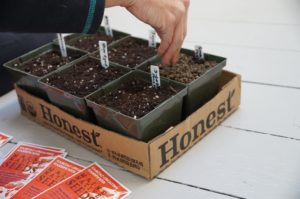
Seeds may be sown densely in 4-inch pots and covered with sand. Photo: ©Lisa Looke, courtesy of Wild Seed Project.
After sowing the seeds, cover with coarse sand rather than potting soil. The sharp grit of the sand keeps the rain from splashing out the seeds and creates a dry surface that prevents rot at the base of the seedling. Different seeds need to be covered in different amounts – a good rule of thumb is to sow the seeds as deep as they are thick. Very small seeds are barely covered, if at all. Label the name and date with a durable plastic label. Water with a gentle nozzle until thoroughly wet and place in the shade.
Waiting for Germination
Each species has its own timetable for germination. In spring, check on your seed flats (if they are not still buried in snow). You might be surprised by how early some species germinate, which can even be in March when the temperatures are still regularly dipping below freezing. With other species, it may be the heat of summer before the first seedling appears. In wild plants, germination can happen over a period of weeks, months, and even years. This is a good strategy for wild plants as offspring are dispersed over time. If there is a drought, period of cold, or heatwave that kills the germinated seedlings, there are still dormant seeds awaiting another chance at life. That said, I regularly experience very good germination with native seeds sown in my nursery.
Collecting Seeds from Wild Plants
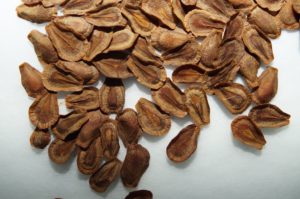
Milkweed seeds (Asclepias syracia). Photo: ©Lisa Looke, courtesy of Wild Seed Project.
Many people are interested in collecting their own seeds. A healthy wild plant population usually produces an abundance of seeds and can still maintain a viable population with you collecting a few seeds. This is the only sustainable way to acquire wild plants. Digging up root divisions in the wild is not propagation. While it may be permissible for you to do this on your own land with common species, it is not a responsible way of getting more native plants into the landscapes.
Protocol for Collecting Native Seed
If you are interested in collecting your own seed, you need to do some homework before even beginning:
1) Make sure you have correctly identified the species. Visit the GoBotany website Go Botany to help you identify the species and determine if it is a rare species, in which case you may NOT collect the seed since it is illegal to do so.
2) If it is not your land, be respectful and ask permission from the landowner before collecting the seed. Also, be aware that it is NOT PERMITTED to collect seeds in national or state parks and often on conservation land.
3) Make sure you know how to handle the seed – research each species’ seed ripening and germination requirements before collecting so that the seed is correctly handled and not wasted. Seed Dispersal: Growing the Future Landscape One Seed at a Time
4) Never collect more than 5% of the seed; make sure it is a healthy population (multiple individuals, not one plant), and be sure to sow the seeds you collect.
Let’s All Sow Some Native Seed
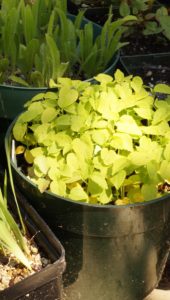
Two-month-old rose mallow (Hibiscus moscheutos) seedlings fill a six-inch pot. Photo: ©Lisa Looke, courtesy of Wild Seed Project.
Every year we humans take up more space, and our native plants are losing ground as a result. It is important to the health of our regional ecosystems and the entire planet that we give space to native plants in our developed landscapes. When you plant a native seed, it grows into a tree or shrub or wildflower that provides food and habitat for many other creatures up and down the food chain, from pollinating insects to birds and other fauna, even the invisible creatures of the soil.
Growing plants from seed is exciting and enjoyable. You will feel proud of your little plants. Wild Seed Project’s mission is to inspire people to take action and join us in increasing the presence of native plants grown from wild seeds. Visit the Wild Seed Project website for more guidance on native seed sowing, purchasing native seeds, taking our Pledge to Rewild, and for lots of excellent resources and publications on all aspects of growing native plants. Wild Seed Project
About the Author
Heather McCargo is the founder of Wild Seed Project, a Maine 501c3 nonprofit organization based in Maine.
***
Each author appearing herein retains original copyright. Right to reproduce or disseminate all material herein, including to Columbia University Library’s CAUSEWAY Project, is otherwise reserved by ELA. Please contact ELA for permission to reprint.
Mention of products is not intended to constitute endorsement. Opinions expressed in this newsletter article do not necessarily represent those of ELA’s directors, staff, or members.

